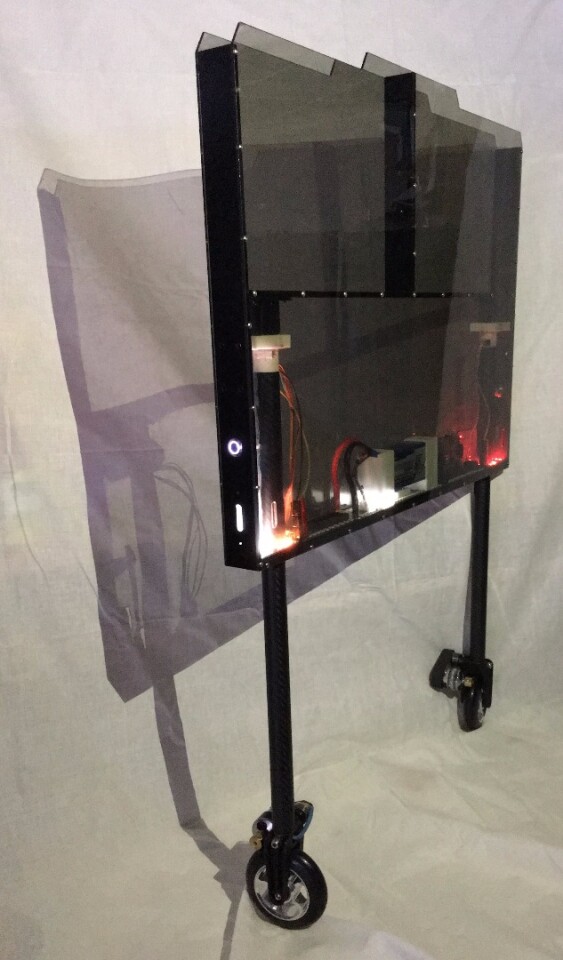When picturing the autonomous delivery services of the near-future, you'll likely imagine drones buzzing overhead with packages in tow. But some ground-based robots are making a push into this area too, like the six-wheeled delivery droid recently dispatched to a customer's home with a food order onboard. Taking a similar approach is the team at LastMileRobotics, who is building a robotic courier based on a tried-and-true methods of the good ol' fashioned bike messenger.
Taking a two-wheeled approach to autonomous delivery could offer the same traffic-avoiding, cost-saving benefits of other concepts, such as those from the aforementioned Starship Technologies and airborne variants from Amazon and Flirtey. But the so-called TWILL bots (two-wheels in line locomotion) would be skinny and agile enough to roll up to your door. They could also boast a bigger range than drones, and lessen the risk of collisions with pedestrians and other vehicles.
"TWILL bots stand tall, on the scale of cars," LastMileRobotics co-founder Chris Tacklind explains to New Atlas. "This allows them to be seen as just another vehicle. But they are skinny, so they don't take up a lane of traffic. The big wheels allow them to traverse large cracks and even curbs. Their agility allows them to navigate pretty much anywhere people walk."

That's the idea anyway. The team has a lot of work to do before we actually see these things on the streets, but it says that in terms of basic mechanics they've got the big pieces in place. Kind of like a bicycle, the vehicle travels with two wheels in line, and when it comes to a stop, it turns one wheel to give it the stability needed to stay upright.
"Bicycles actually have a carefully selected geometry to make them self-stable at speed," Tacklind says. "We use an unstable neutral geometry that gives us higher control authority. We use tiny corrections in the steering angle to control the 'roll' of the vehicle. This actually harnesses the forward momentum to keep it upright. When stopped it is like a 'fixie bike.' With one the wheel turned, it balances like half of a Segway. When executed properly, you can barely see it move."
This kind of all-electric vehicle would be mechanically simple, Tacklind says, with no gyroscopes, kick stands, belts, chains or gears, making for an expected life of 250,000 mi (402,000 km), with the ability to handle terrain like a mountain bike (and possibly one day even tackle stairs).
The production version will most likely have a range of around 20 mi (32 km), Tacklind tells us, something that will be determined by the battery selection. For the compartment size, the team is planning to match the trunk of a Toyota Prius and give the robot a width of 17 in (43 cm), wide enough to handle the largest standard Amazon boxes. Top speed will likely be limited to 25 mph (40 km/h), a figure hoped to comply with common electric vehicle regulations.

The team has built a prototype, though it must be said, at this stage the TWILL bot is definitely more whiteboard-on wheels than robo-bike messenger. It stands one meter tall and 4.5 cm wide (39 x 1.7 in) and the team has used it to deliver manila folders indoors, but it is now making moves to get the robot out of the lab and into the world, though there are external factors that could impact its success.
"We have demonstrated basic functionality, so there is plenty of work do do," says Tacklind. "We are reaching out to academic groups and the open source community to push forward too. Ultimately, we will be limited by regulatory concerns which are being pushed by the self-driving car industry."
Part of that development work will also include the self-driving tech. "At this point we are 'autonomy agnostic'," Tacklind explains. "We don't want to be wed to our own autonomy solution. We'll use the best technology available for each market. There are plenty of vendors supplying autonomy hardware and software."
Source: LastMileRobotics








